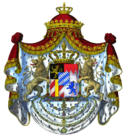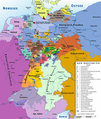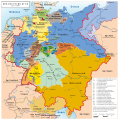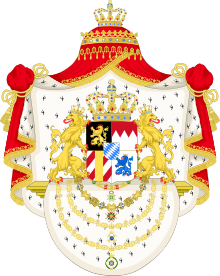Kingdom of Bavaria
|
||||||||||||||||||||||||||||||||||||||||||||

The Kingdom of Bavaria was a state in Central Europe. It had its origins in the peace treaty concluded on December 26, 1805 at the Peace of Pressburg between the agents of the French emperor Napoleon Bonaparte and the German and Austrian emperors Franz . On January 1, 1806, the proclamation of King Maximilian I Joseph took place in Munich .
The state territory comprised the Electorate of Bavaria , numerous secularized old Bavarian areas such as the former imperial principalities of the Hochstift Passau and the prince-provost of Berchtesgaden ( Berchtesgadener Land ) as well as the Rupertiwinkel , the Palatinate on the left bank of the Rhine and large parts of Franconia and Swabia .
The kingdom existed until 1918 when its last king, Ludwig III. left the country due to the November Revolution at the end of the First World War and fled into exile in Hungary. With the establishment of the Free State of Bavaria and temporarily the Soviet Republic of Bavaria , a new state was not founded in Bavaria, but Bavaria was ultimately reorganized as a parliamentary republic .
history
Creation and territorial expansion
In the Treaty of Lunéville in 1801, Kurpfalzbayern, like other states of the then Holy Roman Empire, had to renounce its areas on the left bank of the Rhine in favor of France . With that it lost the parts of the Electoral Palatinate and the Duchy of Jülich-Berg on the left bank of the Rhine . The electorate of Bavaria was awarded parts of Franconia and Swabia at the Reichsdeputationshauptschluss in 1803; but it had to hand over the remaining part of the Electoral Palatinate on the right bank of the Rhine to Baden . In 1805 Bavaria was bound by the Bogenhausen Treaty to the France of Emperor Napoleon . While the new 30,000 strong Bavarian army held Austrian troops at Iglau on December 2, 1805 , Napoleon won the Battle of the Three Emperors at Austerlitz . The Treaties of Brno and the Peace of Pressburg brought Bavaria great land gains, including all of Tyrol and Vorarlberg , the Austro-Swabian margraviate of Burgau, the imperial city of Augsburg and the area around Lindau. Ansbach, Eichstätt and the Passau Ilzland also became part of the new Bavaria. In March 1806 Bavaria ceded the Duchy of Berg on the right bank of the Rhine to Napoleon in exchange for the Principality of Ansbach .
In the Peace of Pressburg , which was signed on December 26, 1805 between France and the German Emperor Franz II , Bavaria, allied with Napoleon, was proclaimed a kingdom . Elector Maximilian IV. Joseph of Bavaria - ruler of the Bavarian spa since 1799 - officially accepted the title of "King Maximilian I of Bavaria" on January 1st, 1806. Maximilian Joseph inherited the Duchy of Pfalz-Zweibrücken in 1795 , but it was already occupied by the French Revolutionary Army. In 1799 he became Elector of Bavaria as the successor to Elector Karl Theodor, who died without any legitimate descendants .
The forced drafting of recruits for the Bavarian army led to the uprising of the Tyroleans under Andreas Hofer , which began on April 9, 1809 in the Tyrolean capital Innsbruck and ended on November 1, 1809 with the defeat of the Tyroleans on the Bergisel . The Paris Treaty of February 28, 1810 between France and Bavaria led to regional consolidation. Bavaria was given the Margraviate Bayreuth , the Principality of Regensburg , the Innviertel , half of the Hausruckviertel as well as the Rupertiwinkel (until 1803 Prince Archbishopric of Salzburg ) and the Berchtesgadener Land (until 1803 heartland of the Prince Provosty of Berchtesgaden ) as territories. In return, southern Tyrol and some Swabian areas had to be surrendered. The border agreement between Bavaria and Württemberg of May 18, 1810 and the respective territorial assignments created the border that still exists today.

King Maximilian's Minister Maximilian Graf von Montgelas is considered to be the creator of the modern Bavarian state. On May 1, 1808, the Bavarian Constitution was enacted, which granted freedom and equality rights and defined the king as the state organ. The king had to swear the constitution and was thus subject to it. At the same time, the constitution erased any relics of serfdom left by the old empire . The religious edicts of January 10, 1803 and June 14, 1809 gave all three Christian denominations equal rights - Catholics, Reformed and Lutherans.
In 1807 the corporate tax privileges were abolished. In 1805 all hereditary and viable offices were abolished by the great service pragmatics. The Munich regulation of 1805 and the Jewish edict of 1813 granted the Israelites in the new Bavaria their first freedoms.
On August 27, 1807, Bavaria was the first country in the world to introduce a smallpox vaccination . The Bavarian gendarmerie was founded in 1812 . A new penal code drafted by Anselm von Feuerbach abolished torture in 1813.
As a result of the Congress of Vienna in 1814/15, Bavaria had to largely give up its gains in Tyrol and Salzburg as well as the regained Innviertel. But to compensate it got back parts of the Palatinate on the left bank of the Rhine and Franconian areas around Würzburg and Aschaffenburg . The new borders were ultimately set by the Treaty of Munich in 1816. The Baden-Bavarian border dispute over the Palatinate on the right bank of the Rhine with the old Wittelsbach residences Mannheim , Schwetzingen and Heidelberg was then decided in favor of Baden at the Aachen Congress in 1818 .
On February 2, 1817, the Bavarian king dismissed Montgelas at the urging of some of his opponents.
Kingdom of Bavaria in the Rhine Confederation 1806,
with TyrolKingdom of Bavaria in the Confederation of the Rhine in 1812,
with SalzburgKingdom of Bavaria in the German Confederation in 1816,
with the Palatinate
Constitution of the Kingdom
In 1818 Maximilian I Joseph issued the constitution of 1818 , which, in contrast to the constitution of 1808, also regulated the question of popular representation. She added political freedoms to civil liberties. "There is probably no country in Europe now where people speak more freely, write more freely and act more openly than here in Bavaria," said Anselm von Feuerbach in 1818. The new constitution provided for a division into two chambers. In the first chamber sat representatives of the clergy and the nobility, as well as other persons appointed by the king. The second chamber was filled by indirect census voting. With it, Bavaria became a constitutional monarchy . The constitution of the Kingdom of Bavaria, granted in 1808 and largely revised in 1818, remained in force in this form (with certain additions and changes) until the end of the monarchy in 1918, i.e. for exactly 100 years.
Bavarian money: guilders and cruisers
From 1806 the Bavarian coinage system applied in the new kingdom, it standardized the coinage in the kingdom and ended the coin chaos that had arisen through the old kingdom. The term “coin” is to be taken literally, because Bavarian paper money did not exist until 30 years later. Sixty cruisers were worth one guilder . The Bavarian coins were minted centrally in Munich by the royal mint . Even the smallest values of the Bavarian currency, such as B. One and six cruiser pieces, carried the portraits of the Bavarian kings. The Bavarian coat of arms with a crown was always shown on the opposite side.
In 1836, the Bayerische Hypotheken- und Wechsel-Bank was given the privilege of issuing Bavarian banknotes . This made it the Bavarian central bank. 100,000 guilders in banknotes of 10 guilders formed the basis of the new era of money economy in the kingdom in 1836. Contrary to the skepticism of Bavarian politicians and bankers, these new notes soon became an accepted and popular means of payment. In 1839, Bavarian 100 guilder notes were also printed for the first time. From December 4, 1871, the Bavarian guilder was replaced by the new “ Mark ”, which was uniform throughout the empire .
Bavaria in the time of the German Confederation
After the death of his father Maximilian I on October 13, 1825, Ludwig I followed . He made Bavaria's capital Munich a center of art and culture. The new king founded universities and promoted school reform in the kingdom. He reorganized the state budget and secured the finances of the kingdom through savings in all areas, including the military budget . With the London Treaty of 1832, the European powers Russia , France and England committed themselves to appoint the Bavarian Prince Otto as the new King of Greece . In 1828 the Bavarian-Württemberg customs union was founded. After the July Revolution in Paris in 1830 and the spread of the revolutionary movement to large parts of Europe, Ludwig's policy showed increasingly reactionary tendencies. He reintroduced censorship and eliminated freedom of the press. Under Ludwig I, the influence of the so-called ultramontanes increased under Karl von Abel . Abel disabled a. a. also the formation of Protestant communities, favored converts to Catholicism and emphasized monarchical authority. The Hambach Festival in 1832 in the Palatinate at Hambach Castle near Neustadt an der Weinstrasse had its roots in the dissatisfaction of the Palatinate population with the Bavarian administration. In 1834 Bavaria joined the German Customs Union .
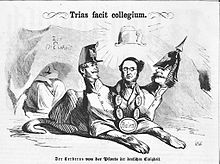
During the pre- March period , inflation and unemployment worsened the living conditions of large sections of the population so drastically that even the middle class threatened impoverishment and the government feared unrest. In the spring of 1848, under the influence of the February Revolution in Paris and the popular movements in Germany , a storm of letters came from all parts of Bavaria to the Bavarian king demanding that national-liberal changes be incorporated into the constitution. On March 6, 1848, the king approved the proposals made by the City of Regensburg's magistrate in a proclamation . He appointed the mayor of Regensburg Gottlieb von Thon-Dittmer as administrator of the interior ministry with the task of forming a March ministry and implementing the royal concessions contained in the proclamation in cooperation with the state parliament. In the further course of events, after a rumored secret return of King Lola Montez's lover, the king abdicated on March 20th . His successor was his son Maximilian II. With his approval, the new government formulated liberal reforms in the areas of state election law, press censorship , assembly and association law, as well as the judiciary and the liberation of peasants , which were passed by the state parliament . However, the implementation of the reforms took a long time and the proposal for a law to emancipate Jews met with strong popular opposition.
By the on March 28, 1849 Frankfurt National Assembly adopted constitution rejected the new king. That triggered the Palatinate uprising . The king called in the Prussian military and on June 10, 1849, a Bavarian army corps also marched into the Palatinate, which put down the uprising. Despite Prussian help in the Palatinate, Bavaria did not participate in the Erfurt Union , with which the Prussian king wanted to partially establish German unity. In the autumn crisis of 1850 , Bavaria stood on the side of Austria and also marched with its troops into Kurhessen , where Bavarian-Austrian and Prussian armies faced each other.
Together with his minister Ludwig von der Pfordten , Maximilian pursued the concept of the Trias Politics, a third Germany, in the years that followed. The German medium-sized states under the leadership of Bavaria were to develop into the third force alongside the two great powers Prussia and Austria. It therefore took part in the Würzburg conferences . However, the other states were also suspicious of Bavaria.
Maximilian II was King of Bavaria until his death on March 10, 1864. On the same day his eldest son Ludwig was proclaimed king as Ludwig II . After the federal decree of June 14, 1866 against Prussia, the German war began. Bavaria fought alongside Austria against Prussia in the course of the Main campaign and suffered a heavy defeat in the battles near Uettingen on July 26th.
Bavaria and the establishment of an empire
As a result , Prussia founded the North German Confederation in 1867 . Bavaria remained outside the confederation and did not join a southern German confederation that had been proposed in the Peace of Prague . Baden, Württemberg and Hessen-Darmstadt also preferred to come to terms with Prussia directly and not become dependent on Bavaria. As a result of the war of 1866, Bavaria thus enjoyed the only four years in its history (1866–1870) in which it lived de iure fully sovereign = without being incorporated into an overarching state or federation. However, King Ludwig II had to sign a protection and defiance alliance on August 22, 1866 . Thus, in the event of war , the Bavarian army was subordinate to the Prussian king as a federal general. In the war against France in 1870, Bavaria therefore fought on the side of northern Germany.
With the November treaties of November 1870, Bavaria's accession to the North German Confederation was prepared. The Bavarian state parliament only reluctantly and belatedly ratified the imperial constitution of January 1, 1871 , but joined it and the all-German state retrospectively. There was considerable resistance to joining the Prussian-dominated new Reich. The Bavarian government under Prime Minister Otto von Bray-Steinburg was only just able to achieve the required two-thirds majority after great resistance, especially from the Bavarian Patriot Party . When the empire was founded , the journalist Johann Baptist Sigl relentlessly warned against Prussian militarism in the popular daily newspaper Das bayerische Vaterland with the words: "More wars, more cripples, more death lists and more tax slips ..." He compared the new imperial crown with an enlarged Prussian pickel hood .
Despite the resistance to joining the German Empire, Bavaria was able to secure reservation rights as the second largest state . This meant that in some areas Bavaria was allowed to have its own administration instead of the imperial administration. So it remained with its own army, its own diplomacy, its own postal administration and its own railway administration . The reservation rights were then eagerly guarded and emphasized by representative buildings, such as the Army Museum and the Ministry of Transport .
The Kingdom of Bavaria continued to have the right to its own foreign policy in the German Empire and therefore also had its own diplomats. Because of Bavaria's continued foreign policy competencies, most of the foreign ambassadors stayed in Munich: It was not until the First World War that many embassies closed and after the end of the war they were no longer opened due to Bavaria's loss of these competencies.
Late in the evening of June 9, 1886, the "fairytale king" Ludwig II was arrested at Neuschwanstein Castle . A commission from the Bavarian government informed him that he was incapacitated . They spent the night at Berg Castle . His uncle Luitpold took over the reign as Prince Regent the next day on June 10th . When Ludwig II died a few days later, on June 13, 1886, in Lake Starnberg near Berg Castle, his younger brother Otto became King of Bavaria , according to success .
Prince Regent and First World War
Since King Otto was unable to rule due to a mental illness, the Prince Regent Luitpold , the third son of Ludwig I and brother of Max II , continued to run the government. This interim situation then lasted for over a quarter of a century until his death in 1912.
The "Prinzregentenzeit", as the reign of Prince Luitpold is often called, is due to the political passivity of Luitpold as the era of the gradual subordination of Bavarian interests to those of the Reich. In connection with the unfortunate end of the previous rule of King Ludwig II, this break in the Bavarian monarchy had an even stronger effect. According to historians, the constitutional amendment of 1913 finally brought about the decisive break in the continuity of royal rule, especially since this amendment had been approved by the state parliament as representative of the people and thus indirectly meant a step away from a constitutional to a parliamentary monarchy . The combination of these two developments is now considered to be the main cause of the unspectacular and unopposed end of the Bavarian Kingdom in the course of the November Revolution of 1918. After Luitpold's death, his son Ludwig also succeeded as Prince Regent, but after a constitutional amendment decided by the Bavarian State Parliament on November 4, 1913, he officially became King Ludwig III on November 5 . calling out. Otto kept his title of king until his death in 1916, so that Bavaria had two kings (by title).
Through an electoral alliance between the Bavarian Center, as the Bavarian Patriot Party called itself since 1887, and the SPD, the Bavarian suffrage was liberalized in 1906 and thus aligned with that of the Reichstag. The end of the First World War also meant the end of the monarchy in Bavaria. Due to the supply bottlenecks and the losses in the First World War, the support that the monarchy had had among the people waned. The militant appearance of Ludwig III did the rest, advocating an enlargement of Bavaria through annexations after a victorious war ended. His attitude was perceived as too friendly to the Prussians. In the course of the November Revolution , Kurt Eisner proclaimed the Free State of Bavaria on November 7, 1918 . King Ludwig III. was deposed and had to leave Bavaria.
coat of arms
- description
In a heraldic tent , two crowned golden lions standing on their back legs with their front paws raised hold the actual Bavarian coat of arms between them, which consists of six heraldic components.
The main shield is quartered. The golden, red armored Palatinate lion , the coat of arms of the Palatinate, is erected to the right at the top on a black background . The second field shows three silver points pointing upwards on a red background (" Franconian rake "), which represent the Franconian part of the country . In the third field, in blue on a silver background, there is a lion, raised to the right and crowned by a golden crown, the heraldic animal of the County of Pfalz-Veldenz , representative of the northern Rhine Palatinate . Finally, the fourth field shows the coat of arms of the Margraviate of Burgau , on a silver background three red diagonal bars from bottom right to top left, above a gold pole, representing the Swabian part of the country .
The heart shield in the national colors white-blue shows 42 partly silver, partly blue diamonds ( diamond pattern ) rising diagonally from the left to the right side . The golden crown above the coat of arms symbolizes royalty. Below you can see the collans of the four highest Bavarian orders: the Hubertus , the Georgs , the Military Max Joseph and the Order of Merit of the Bavarian Crown .
- history
The characteristic diamonds were taken from the coat of arms of the Counts of Bogen in today's Straubing-Bogen district . Through the marriage of Ludmila of Bohemia with Ludwig I of Bavaria (1204), it came into the possession of the Wittelsbach family and has been used over the centuries as a coat of arms. The coat of arms placed on the diamond coat of arms when the kingdom was proclaimed in 1806 contained the imperial orb and the Palatinate lion. In the same year it was replaced by the vermilion heart shield with a shiny sword with a golden hilt, crossed with a golden scepter. From 1835 the tribes of Bavaria are listed in the shield.
- Coat of arms of the Kingdom of Bavaria
structure
Circles 1808 to 1837
The administrative structure of the Kingdom of Bavaria, founded in 1806, was completely redesigned in 1808 to incorporate the newly acquired territories. With the community edict of May 17, 1818, the communities in Bavaria were also established. Until then, the chairpersons were the administrative units of the lowest level. Bavaria was divided into 15 (state) districts whose names were based on rivers. In 1810 six districts were dissolved, in 1814 another district. In 1816, the Rhine District was formed as a new district and two more districts were dissolved by 1817, so that when the administration was reorganized in 1817, there were only eight districts.
- Altmühlkreis (1808–1810, dissolved)
- Eisackkreis (1808–1810, ceded to Italy)
- Etschkreis (1808–1810, ceded to Italy)
- Illerkreis (1808–1817, dissolved)
- Innkreis (1808–1814, ceded to Austria)
- Isarkkreis (1808–1837, merged in Upper Bavaria)
- Lechkreis (1808–1810, dissolved)
- Mainkreis (1808–1837, renamed Obermainkreis in 1817, merged into Upper Franconia)
- Naabkreis (1808–1810, dissolved)
- Upper Danube District (1808–1837, dissolved in Swabia)
- Pegnitzkreis (1808–1810, dissolved)
- Regenkreis (1808–1837, taken up in the Upper Palatinate)
- Rezatkreis (1808–1837, merged in Middle Franconia)
- Rheinkreis (1816–1837, taken up in the Palatinate )
- Salzachkreis (1808-1816, returned to Austria, it also included the Innviertel )
- Lower Danube District (1808–1837, dissolved in Lower Bavaria)
- Untermainkreis (1817–1837, merged in Lower Franconia)
Circles 1838 to 1918
In 1838, instead of the river names, the districts were given the names of the old duchies. These designations were later transferred to the government districts that still exist today , which, as administrative units of the middle level, largely correspond to today's government districts (except for the Palatinate, which was detached from Bavaria in 1946 ).
The districts that remained in 1838 were divided into district offices . The forerunners of the district offices, the regional courts , were originally administrative and judicial authorities at the same time, which was considered a structural flaw in the Bavarian constitution, since it affected judicial independence after the judge (in his function of administrative officer, which corresponded to that of today's district administrator) was bound by instructions. It was not until 1862 that this deficiency was remedied with the introduction of the district offices to which the administrative business was transferred. In the Palatinate, land commissariats had existed alongside the regional courts since 1818 . Despite these seemingly rational and uniform territorial divisions, social development in the kingdom was initially characterized by considerable integration problems.
Within the Kingdom of Bavaria, the Palatinate enjoyed a special legal and administrative position, as the Bavarian government retained essential achievements of the French period .
From 1871 the Kingdom of Bavaria was the second largest state of the German Empire, 75,865 km², consisting of the larger eastern main part (69,928 km²) and the small western part of the Palatinate (Rheinpfalz, Rhine-Bavaria; 5,937 km²).
- Upper Bavaria (district capital and district government Munich )
- Lower Bavaria ( Landshut )
- Palatinate ( Speyer )
- Upper Palatinate and Regensburg ( Regensburg )
- Upper Franconia ( Bayreuth )
- Middle Franconia ( Ansbach )
- Lower Franconia and Aschaffenburg ( Würzburg )
- Swabia and Neuburg ( Augsburg )
Kings

List of Bavarian rulers
- Maximilian I. Joseph , 1806-1825
- Ludwig I. , 1825-1848
- Maximilian II. Joseph , 1848–1864
-
Ludwig II. , 1864–1886 (incapacitated in 1886)
- Prince Regent: Luitpold , 1886
-
Otto I. , 1886–1916 (incapable of government)
- Prince Regent: Luitpold , 1886–1912
- Prince Regent: Ludwig (III.) , 1912–1913
- Ludwig III. , 1913-1918
Title of the Bavarian kings

King Ludwig I in royal robe (1826).
New Pinakothek , Munich .
At the top of the crown is a diamond, the blue Wittelsbacher .
From January 1st, 1806, the Bavarian royal title was initially:
“ By the grace of God, King of Bavaria, the Holy Roman Empire Arch-Palatinate Count, Erztruchseß and Elector. "
The spelling Baiern with "i" was initially the usual one in official use. It was only King Ludwig I, a supporter of philhellenism , who issued an ordinance according to which the country's name must always be written with a "y". The titles relating to the Reich ceased to exist in 1806 when Bavaria joined the Rhine Confederation.
On October 18, 1835, Ludwig I issued another ordinance, according to which the great royal title was from now on:
" By God's grace, King of Bavaria, Count Palatine near the Rhine, Duke of Bavaria, Franconia and in Swabia etc. etc. "
What about "etc. etc. ”is meant, does not explain the aforementioned regulation and even at a later point in time an authentic interpretation never appeared. An announcement of October 3, 1804 offers a certain interpretation aid, which however became partially inapplicable due to the following changes in constitutional law. The electoral title is defined therein:
" N. in Upper and Lower Bavaria, the Upper Palatinate, in Franconia, to Kleve and Berg Herzog, Prince of Bamberg, Würzburg, Augsburg, Freising and Passau, Prince and Lord of Kempten, Landgrave of Leuchtenberg, Prince Count of Mindelheim, Count in the Mark, to Ravensberg, Ottobeuren and Helfenstein, Herr zu Ulm, Rothenburg, Nördlingen, Schweinfurt, Wettenhausen, Roggenburg, Ursberg, Elchingen, Söflingen, Irrsee, Memmingen, Ravensburg, Wangen, Kaufbeuren, Buchhorn, Leutkirch and Bopfingen etc., des Holy Roman Empire Hereditary Palatinate Count, Archtruchseß and Elector. "
Here, too, there is already an "etc."
What is meant by this is probably: All titles to which an elector or king of Bavaria is legally entitled, the determination of which would have caused both jurists and historians great difficulties. Ultimately, in the "etc. etc. "see both a placeholder for all titles that the rulers of Bavaria have ever used and which they have not expressly waived (by international treaty) or tacitly (by omitting the coat of arms of an area in their coat of arms after the area has been lost).
At the audience for the proclamation of the king on January 1, 1806 and also in the government gazette, the solemn coronation and anointing were reserved for a later date. The insignia ordered in Paris arrived in March 1807. The crown of the Kingdom of Bavaria was not worn, but was placed on the catafalque when the Bavarian kings were enthroned and at royal funerals. Today it is in the treasury of the Munich residence.
military
1790 to 1871
The year 1790 brought a fundamental reform of the Bavarian army: all field troops received a uniform of uniform cut and instead of a hat a leather helmet with horsehair tail. This was named "Rumford- Kaskett " after the then Minister of War and the initiator of the reform, Count Rumford . Elector Maximilian IV. Joseph found the Bavarian army in miserable condition when he took office in 1799: Hardly any of the regiments were anywhere near nominal strength, the level of training of the troops was poor and the Rumford uniforms were unpopular and impractical. The young elector, who in the ancien régime himself had been colonel in the French regiment of foreigners, the Royal Deux Ponts , made building a modern armed force one of his main tasks. For the infantry there was a return to the traditional light blue uniform color and led in 1801 for all weapons classes to soon characteristic of the Bavarian army Raupenhelm one.
The Bavarian army was reformed by capable generals like Deroy , Wrede and Triva based on the French model and soon became Germany's most modern armed force. The Bavarian army was the first in German-speaking countries to abolish corporal punishment . In addition to the field army, which is largely based on conscription , a national guard with three classes was set up (1st class: reserve battalions of line regiments, 2nd class: Landwehr , 3rd class: civilian military ). In 1800 one had to fight reluctantly on Austria's side against France, but when Austria invaded Bavaria for the third time in 100 years in 1805 , it was faced with a powerful army. She only drew back in order to connect with the advancing army of Napoleon and then to strike back. This was done quickly, methodically and thoroughly. 30,000 Bavarians took part in the successful siege of Ulm and the subsequent liberation of Bavaria. In the Battle of Austerlitz they secured Napoleon's flanks and supply routes. In 1806/07 they forced several Prussian fortresses to surrender. The unrest that broke out in part with Austrian support in the province of Tyrol , which Napoleon had assigned to Bavaria, developed in 1809 into a veritable popular uprising that could only be suppressed with French help. When Austria invaded Bavaria again in 1809, the French army was mostly tied up in Spain , so that Napoleon's renewed campaign against the Habsburgs was initially only carried out with a predominantly Bavarian military. In the Battle of Wagram , the deployment of the Bavarian Army was decisive.

The Bavarian army suffered terrible losses in the Russian campaign . The battle of Polotsk in mid-August 1812 resulted in high blood tolls; essentially only Bavarian cavalry advanced in the direction of Moscow. Of the 33,000 or so men who marched out in 1812 (including reinforcements sent on), only about 4,000 returned. Pressed by the Crown Prince and Wrede, King Max I Joseph turned away from France with a heavy heart and moved to the Allied camp shortly before the Battle of Leipzig . Wrede's attempt to stop the Grande Armée's march through in the Battle of Hanau in 1813 ended with a minor defeat for the Bavarian-Austrian corps he commanded. In the French campaign of 1814, which was initially unsuccessful for the Allies, he made up for this defeat and was able to win valuable victories over his former ally in the battles at Arcis-sur-Aube and Bar-sur-Aube .
After the decision of the federal execution against Prussia by the German Bundestag in Frankfurt , the German war began . The mobilization of the Bavarian army, ordered on May 10, 1866, was not completed until June 22, at which time the Prussian army was almost in Bohemia. This war was very unfortunate for the Bavarian army. The Bavarian Commander-in-Chief Prince Karl , who was also subordinate to the southern German federal troops , learned in Meiningen of the surrender of the Hanoverians after the battle of Langensalza when he was hurrying to the aid of the Kingdom of Hanover . Since the Prussians advanced quickly, a union with a federal corps further west under Prince Alexander of Hesse was not possible, whereupon the Bavarian troops withdrew to Kissingen . After heavy fighting, the Bavarian army withdrew to Schweinfurt and Würzburg . Only the Marienberg Fortress and a city district could be held there. On August 1, 1866, a Prussian reserve corps occupied Nuremberg .
When the relationship between France and Prussia came to a head in the course of Leopold von Hohenzollern's candidacy for the Spanish throne in 1869 , the Bavarian War Minister Siegmund von Pranckh had the two Bavarian army corps mobilized on July 14, 1870. The 1st Army Corps under Ludwig von der Tann and the 2nd Army Corps under Jakob von Hartmann moved within the III. Army under Friedrich Wilhelm of Prussia in the Franco-Prussian War (1870/71). The Bavarian troops under Weißenburg , which was stormed by Hartmann , successfully took part in the Battle of Wörth , the Battle of Beaumont , the Battle of Sedan and the Siege of Paris . Over 5,000 Bavarian soldiers died during the war.
1871 to 1918
The army of the Kingdom of Bavaria existed until 1918. The Bavarian king had the right to supreme command of the Bavarian army in times of peace (based on the military convention of November 1870). During the First World War , the Bavarian troops fought under the supreme command of the German Empire. The Free State of Bavaria renounced military sovereignty in the Bamberg constitution of August 14, 1919 .
literature
- Alois Schmid , Katharina Weigand (Hrsg.): Bavaria in the middle of Europe. From the early Middle Ages to the 20th century. Beck, Munich 2005, ISBN 3-406-52898-8 .
- Hans-Michael Körner : History of the Kingdom of Bavaria. Beck, Munich 2006, ISBN 3-406-53591-7 .
- Benno Hubensteiner : Bavarian History. State and people, art and culture . Rosenheimer Verlagshaus, Rosenheim 2009, ISBN 978-3-475-53756-1 .
- Wolfgang Wüst : Crown and Integration. On the state-supporting role of the House of Wittelsbach in Franconia and Swabia 1806–1918. In: Alois Schmid, Hermann Rumschöttel (ed.): Wittelsbacher studies. Ceremony for Duke Franz of Bavaria on his 80th birthday. (Series of publications on Bavarian regional history, 166). Beck, Munich 2013, ISBN 978-3-406-10781-8 , pp. 679-696.
Web links
- Kingdom of Bavaria (district offices and municipalities) 1910
- Map of the Kingdom of Bavaria , scale 1: 600,000, by F. Handtke, 16th edition (published before 1918)
- bavarikon (Internet portal of the Free State of Bavaria with digitized content from the fields of art, culture and history)
- House of Bavarian History : History of Bavaria - in six languages
- House of Bavarian History: "Kingdom of Bavaria 1806–1918"
- House of Bavarian History: Image archive on Bavarian history - including images and videos
- Historical lexicon of Bavaria
Individual evidence
- ^ A b Johann Josef Scotti: Collection of laws and ordinances ... Volume 2, Düsseldorf: Joseph Wolf, 1821, p. 977 ( Uni Bonn )
- ^ Border treaty between Bavaria and Württemberg from 1810 as text at Wikisource .
- ↑ The Bavarian Religious Edict of January 10, 1803 and the beginnings of the Protestant regional church in Bavaria - a memorial sheet
- ↑ Edict on the external legal relationships of the inhabitants of the Kingdom of Bavaria in relation to religion and ecclesiastical societies, for the more detailed definition of §§ VI. and VII. of the first title of the constitution
- ↑ See also Bavarian Jewish edict of 1813 .
- ↑ Criminal Code for the Kingdom of Bavaria
- ^ House of Bavarian History : Montgelas' dismissal
- ^ Coin Convention of August 25, 1837 in the Google book search
- ↑ Helmut Kahnt, Bernd Knorr: Old measures, coins and weights: a lexicon. Licensed edition of the Bibliographisches Institut, Leipzig. Bibliographisches Institut, Mannheim, Vienna, Zurich 1986, ISBN 978-3-411-02148-2 , pp. 114–116; here: p. 115.
- ↑ Augsburger Allgemeine : Kingdom of Bavaria: Entry into a new era of the money economy
- ↑ Dieter Albrecht: Regensburg im Wandel, studies on the history of the city in the 19th and 20th centuries . In: Museums and Archives of the City of Regensburg (Hrsg.): Studies and sources on the history of Regensburg . tape 2 . Mittelbayerische Druckerei und Verlags-Gesellschaft mbH, Regensburg 1984, ISBN 3-921114-11-X , p. 132 f .
- ^ Benno Hubensteiner: Bavarian history. Bavaria and the establishment of an empire. 9th edition, 1981, ISBN 3-7991-5684-4 , p. 431.
- ^ Historical Lexicon of Bavaria : Foreign legations in Munich
- ↑ Herder's Konversationslexikon. 3rd edition, volume 1. Freiburg 1902, column 1203.
- ↑ Königlich-Baierisches Regierungsblatt , Munich 1808, column 1481–1502. On-line
- ↑ Reg. Bl. 1804, Col. 849 ff.
